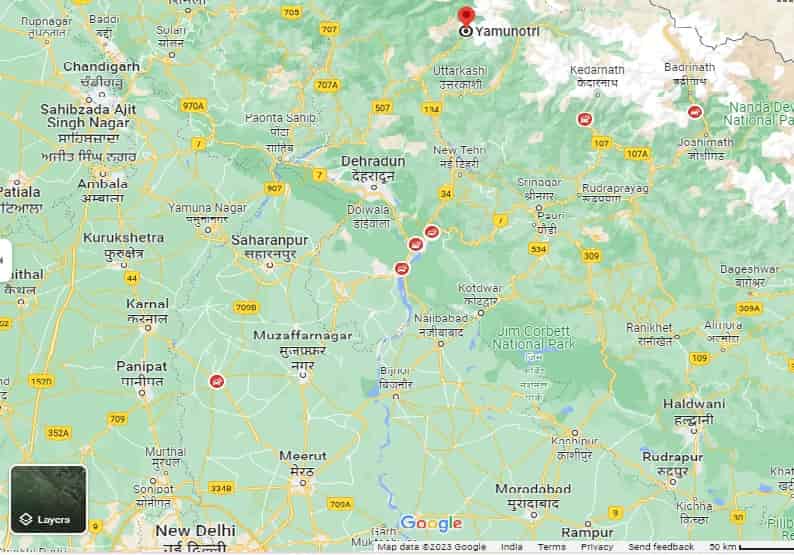Yamunotri Yatra Route Map
Yamunotri, nestled in the breathtaking Garhwal Himalayas of Uttarakhand, is a revered pilgrimage site and holds immense religious significance for Hindus. Devotees from all over the country embark on the challenging yet spiritually fulfilling Yamunotri Yatra to seek the blessings of the goddess Yamuna. To make this divine journey smoother and more accessible, having a comprehensive route map becomes crucial. In this article, we will guide you through the various routes and landmarks on the Yamunotri Yatra, ensuring that you experience a seamless pilgrimage.

Introduction to Yamunotri and its significance
Yamunotri, the source of the sacred Yamuna River, is believed to be the birthplace of the goddess Yamuna. It is one of the four holy shrines of the Chota Char Dham Yatra, along with Gangotri, Kedarnath, and Badrinath. According to Hindu mythology, a visit to Yamunotri is said to cleanse one’s sins and provide spiritual liberation.
Overview of the Yamunotri Yatra
The Yamunotri Yatra is a challenging pilgrimage that requires determination, physical endurance, and strong faith. The journey involves trekking through rugged terrains, crossing rivers and bridges, and braving unpredictable weather conditions. However, the reward of witnessing the serene beauty of the Himalayas and connecting with the divine makes it all worthwhile.
Importance of a route map in the Yatra
Having a well-defined route map is essential for a successful Yamunotri Yatra. It not only helps in planning the journey but also ensures that pilgrims stay on the right path and don’t face unnecessary difficulties. The route map provides vital information about the distances, landmarks, accommodation options, and other essential details needed for a smooth pilgrimage.
Starting point of the Yamunotri Yatra
The Yamunotri Yatra traditionally begins from the town of Hanuman Chatti, which is located at an altitude of approximately 2,440 meters. This picturesque town acts as the base camp for the pilgrimage and offers various facilities for the convenience of the pilgrims.
Route Map for the Yamunotri Yatra
Delhi to Yamunotri Route
The journey from Delhi to Yamunotri is a popular choice for many pilgrims. Here is a step-by-step guide to the route:
Delhi to Haridwar
The first leg of the journey is from Delhi to Haridwar, a major pilgrimage city in Uttarakhand. You can reach Haridwar by road or train, with regular transportation options available. Upon reaching Haridwar, take some time to visit the famous Har Ki Pauri ghat and attend the mesmerizing Ganga Aarti.
Haridwar to Barkot
From Haridwar, proceed towards Barkot, a scenic town situated at an altitude of around 1,220 meters. The distance between Haridwar and Barkot is approximately 170 kilometers, and it takes around 6-7 hours to cover the journey by road. Enjoy the picturesque views of the Garhwal Himalayas as you make your way to Barkot.
Barkot to Janki Chatti
From Barkot, the next stop is Janki Chatti, which serves as the base camp for the trek to Yamunotri. Janki Chatti is around 7 kilometers away from Barkot, and you can reach there by road. The route from Barkot to Janki Chatti offers breathtaking views of the mountains and the Yamuna River.
Janki Chatti to Yamunotri
The final leg of the journey involves a trek from Janki Chatti to Yamunotri. It is a 6-kilometer uphill trek that takes approximately 3-4 hours, depending on your pace. The trail is well-marked and offers stunning vistas of the surrounding Himalayan peaks. As you approach Yamunotri, the sight of the Yamuna River gushing through the mountains fills you with a sense of awe and reverence.
Dehradun to Yamunotri Route
Another popular route to reach Yamunotri is via Dehradun. Here’s a brief overview of the route:
Dehradun to Barkot
Start your journey from Dehradun, the capital city of Uttarakhand. Dehradun is well-connected by road, rail, and air, making it easily accessible for pilgrims. From Dehradun, drive towards Barkot, covering a distance of approximately 135 kilometers. Enjoy the scenic beauty of the Himalayas as you make your way to Barkot.
Barkot to Janki Chatti
Once you reach Barkot, continue your journey towards Janki Chatti. The distance between Barkot and Janki Chatti is around 42 kilometers, and it takes about 2-3 hours to cover the road journey. The route offers enchanting views of the valleys and forests, providing a soothing experience for the pilgrims.
Janki Chatti to Yamunotri
From Janki Chatti, embark on the trek to Yamunotri. The trek route is the same as mentioned earlier, with a 6-kilometer uphill trail that takes you closer to the sacred shrine. As you walk amidst the serene surroundings, the sound of the flowing Yamuna River accompanies you, creating a sense of tranquility and devotion.
Rishikesh to Yamunotri Route
For those starting their journey from Rishikesh, here’s an outline of the route:
Rishikesh to Barkot
Commence your Yamunotri Yatra from Rishikesh, known as the “Yoga Capital of the World.” From Rishikesh, travel towards Barkot, covering a distance of approximately 170 kilometers. The route takes you through scenic landscapes, charming villages, and winding roads, offering a delightful experience to the pilgrims.
Barkot to Janki Chatti
Once you reach Barkot, the next phase of the journey involves traveling to Janki Chatti. The distance between Barkot and Janki Chatti is around 42 kilometers, and it takes approximately 2-3 hours to complete the road journey. The road meanders through the picturesque valleys, allowing you to soak in the beauty of nature.
Janki Chatti to Yamunotri
Embark on the final stretch of the Yamunotri Yatra by undertaking a 6-kilometer uphill trek from Janki Chatti to Yamunotri. This trek offers a blend of natural splendor and spiritual serenity. The trail passes through lush green meadows, dense forests, and icy streams, making it a memorable experience for pilgrims.
Important landmarks along the Yamunotri Yatra route
As you undertake the Yamunotri Yatra, several significant landmarks dot the route, enhancing the spiritual journey. Some notable landmarks include:
- Hanuman Chatti: The starting point of the Yamunotri Yatra and a hub for accommodations and facilities.
- Surya Kund: A hot water spring near the Yamunotri Temple, where devotees perform rituals before entering the temple.
- Divya Shila: A sacred rock pillar located near the Yamunotri Temple, symbolizing the divine presence of Yamuna.
- Kharsali: A village en route to Yamunotri, known for its ancient Shani Temple and warm hospitality.
- Yamunotri Temple: The main pilgrimage site dedicated to the goddess Yamuna, where devotees offer prayers and seek blessings.
Preparations and tips for the Yamunotri Yatra
To ensure a safe and comfortable Yamunotri Yatra, it is essential to make adequate preparations. Here are some tips to keep in mind:
- Physical Fitness: Engage in regular physical exercise and stamina-building activities to prepare your body for the trek and altitude.
- Weather Awareness: Check the weather forecast before embarking on the journey and carry appropriate clothing and gear accordingly.
- Pack Essentials: Carry essential items such as comfortable footwear, warm clothing, rain gear, first aid kit, and necessary medication.
- Stay Hydrated: Carry an ample supply of water and stay hydrated throughout the journey.
- Seek Local Guidance: Interact with locals and seek guidance regarding the route, weather conditions, and safety precautions.
- Respect Nature and Culture: Maintain cleanliness, avoid littering, and respect the religious sentiments associated with the pilgrimage.
Conclusion
The Yamunotri Yatra is a transformative journey that offers a blend of natural beauty, spiritual enlightenment, and physical challenges. The route map guides pilgrims through different starting points, trekking trails, and landmarks, ensuring a memorable and fulfilling experience. As you traverse the scenic landscapes and connect with the divine energy of Yamunotri, let your heart be filled with gratitude and devotion.
FAQs (Frequently Asked Questions)
Q: Can the Yamunotri Yatra be undertaken by people of all age groups?
A: The Yamunotri Yatra involves a trek and can be physically demanding. It is advisable to assess one’s health and fitness before undertaking the journey, especially for elderly individuals or those with health conditions. It is recommended to consult with a healthcare professional before planning the pilgrimage.
Q: What is the best time to undertake the Yamunotri Yatra?
A: The Yamunotri Yatra season generally starts in April/May and continues until October/November. The best time to visit is during the summer months (May to June) when the weather is pleasant. It is advisable to avoid the monsoon season (July to September) due to heavy rainfall and the winter season (November to April) when the region experiences harsh weather conditions.
Q: Are there any accommodation options available along the Yamunotri Yatra route?
A: Yes, there are several accommodation options available at different points along the Yamunotri Yatra route. From basic guesthouses and lodges to more comfortable hotels, pilgrims have various choices to suit their preferences and budgets. It is advisable to make prior bookings, especially during peak pilgrimage seasons.
Q: Are there any restrictions or guidelines to be followed during the Yamunotri Yatra?
A: Yes, there are certain guidelines to be followed during the Yamunotri Yatra. It is important to respect the sanctity of the place, adhere to the rules and regulations of the temple authorities, and maintain cleanliness throughout the journey. Additionally, it is advisable to carry valid identification documents and required permits, if any, for the pilgrimage.
Q: Is it possible to undertake the Yamunotri Yatra as a solo traveler?
A: Yes, solo travelers can undertake the Yamunotri Yatra. However, it is recommended to exercise caution, especially during the trekking portion of the journey. It is advisable to inform someone about your itinerary, travel with a reliable guide if needed, and stay connected with fellow pilgrims for safety purposes.
In conclusion, the Yamunotri Yatra is a spiritually significant journey that takes devotees through awe-inspiring landscapes and challenging terrains. With a well-defined route map and adequate preparations, pilgrims can embark on this sacred pilgrimage, seeking the blessings of the goddess Yamuna. May your Yamunotri Yatra be filled with devotion, peace, and profound experiences that stay etched in your heart forever.


